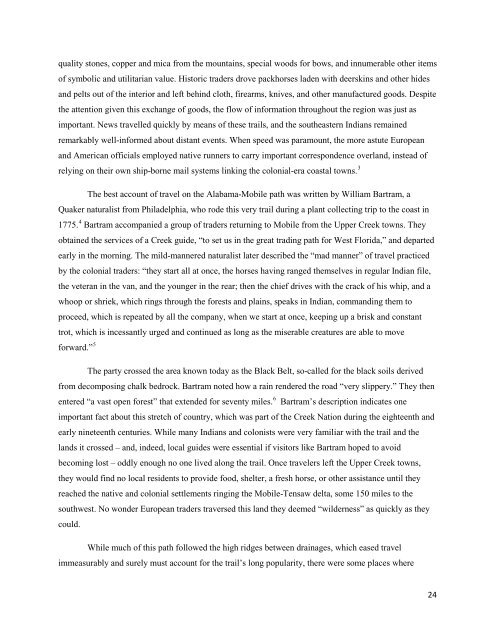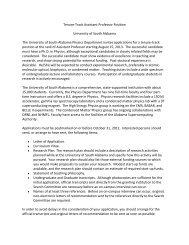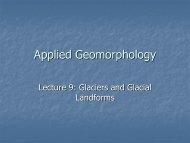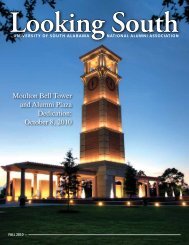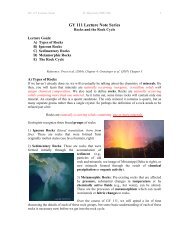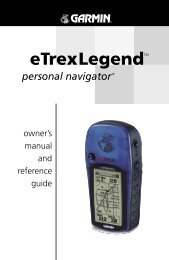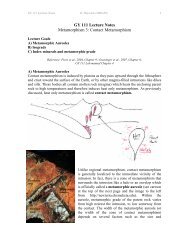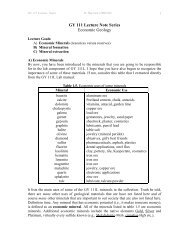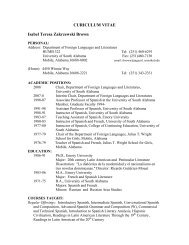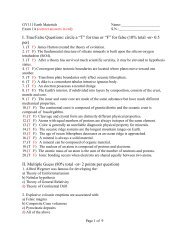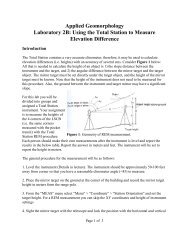Archaeological Survey of the Old Federal Road in Alabama
Archaeological Survey of the Old Federal Road in Alabama
Archaeological Survey of the Old Federal Road in Alabama
Create successful ePaper yourself
Turn your PDF publications into a flip-book with our unique Google optimized e-Paper software.
quality stones, copper and mica from <strong>the</strong> mounta<strong>in</strong>s, special woods for bows, and <strong>in</strong>numerable o<strong>the</strong>r items<strong>of</strong> symbolic and utilitarian value. Historic traders drove packhorses laden with deersk<strong>in</strong>s and o<strong>the</strong>r hidesand pelts out <strong>of</strong> <strong>the</strong> <strong>in</strong>terior and left beh<strong>in</strong>d cloth, firearms, knives, and o<strong>the</strong>r manufactured goods. Despite<strong>the</strong> attention given this exchange <strong>of</strong> goods, <strong>the</strong> flow <strong>of</strong> <strong>in</strong>formation throughout <strong>the</strong> region was just asimportant. News travelled quickly by means <strong>of</strong> <strong>the</strong>se trails, and <strong>the</strong> sou<strong>the</strong>astern Indians rema<strong>in</strong>edremarkably well-<strong>in</strong>formed about distant events. When speed was paramount, <strong>the</strong> more astute Europeanand American <strong>of</strong>ficials employed native runners to carry important correspondence overland, <strong>in</strong>stead <strong>of</strong>rely<strong>in</strong>g on <strong>the</strong>ir own ship-borne mail systems l<strong>in</strong>k<strong>in</strong>g <strong>the</strong> colonial-era coastal towns. 3The best account <strong>of</strong> travel on <strong>the</strong> <strong>Alabama</strong>-Mobile path was written by William Bartram, aQuaker naturalist from Philadelphia, who rode this very trail dur<strong>in</strong>g a plant collect<strong>in</strong>g trip to <strong>the</strong> coast <strong>in</strong>1775. 4 Bartram accompanied a group <strong>of</strong> traders return<strong>in</strong>g to Mobile from <strong>the</strong> Upper Creek towns. Theyobta<strong>in</strong>ed <strong>the</strong> services <strong>of</strong> a Creek guide, “to set us <strong>in</strong> <strong>the</strong> great trad<strong>in</strong>g path for West Florida,” and departedearly <strong>in</strong> <strong>the</strong> morn<strong>in</strong>g. The mild-mannered naturalist later described <strong>the</strong> “mad manner” <strong>of</strong> travel practicedby <strong>the</strong> colonial traders: “<strong>the</strong>y start all at once, <strong>the</strong> horses hav<strong>in</strong>g ranged <strong>the</strong>mselves <strong>in</strong> regular Indian file,<strong>the</strong> veteran <strong>in</strong> <strong>the</strong> van, and <strong>the</strong> younger <strong>in</strong> <strong>the</strong> rear; <strong>the</strong>n <strong>the</strong> chief drives with <strong>the</strong> crack <strong>of</strong> his whip, and awhoop or shriek, which r<strong>in</strong>gs through <strong>the</strong> forests and pla<strong>in</strong>s, speaks <strong>in</strong> Indian, command<strong>in</strong>g <strong>the</strong>m toproceed, which is repeated by all <strong>the</strong> company, when we start at once, keep<strong>in</strong>g up a brisk and constanttrot, which is <strong>in</strong>cessantly urged and cont<strong>in</strong>ued as long as <strong>the</strong> miserable creatures are able to moveforward.” 5The party crossed <strong>the</strong> area known today as <strong>the</strong> Black Belt, so-called for <strong>the</strong> black soils derivedfrom decompos<strong>in</strong>g chalk bedrock. Bartram noted how a ra<strong>in</strong> rendered <strong>the</strong> road “very slippery.” They <strong>the</strong>nentered “a vast open forest” that extended for seventy miles. 6 Bartram’s description <strong>in</strong>dicates oneimportant fact about this stretch <strong>of</strong> country, which was part <strong>of</strong> <strong>the</strong> Creek Nation dur<strong>in</strong>g <strong>the</strong> eighteenth andearly n<strong>in</strong>eteenth centuries. While many Indians and colonists were very familiar with <strong>the</strong> trail and <strong>the</strong>lands it crossed – and, <strong>in</strong>deed, local guides were essential if visitors like Bartram hoped to avoidbecom<strong>in</strong>g lost – oddly enough no one lived along <strong>the</strong> trail. Once travelers left <strong>the</strong> Upper Creek towns,<strong>the</strong>y would f<strong>in</strong>d no local residents to provide food, shelter, a fresh horse, or o<strong>the</strong>r assistance until <strong>the</strong>yreached <strong>the</strong> native and colonial settlements r<strong>in</strong>g<strong>in</strong>g <strong>the</strong> Mobile-Tensaw delta, some 150 miles to <strong>the</strong>southwest. No wonder European traders traversed this land <strong>the</strong>y deemed “wilderness” as quickly as <strong>the</strong>ycould.While much <strong>of</strong> this path followed <strong>the</strong> high ridges between dra<strong>in</strong>ages, which eased travelimmeasurably and surely must account for <strong>the</strong> trail’s long popularity, <strong>the</strong>re were some places where24


